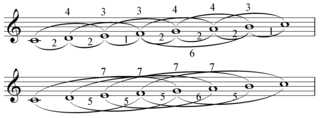
In Western musical notation, a key signature is a set of sharp, flat, or rarely, natural symbols placed on the staff at the beginning of a section of music. The initial key signature in a piece is placed immediately after the clef at the beginning of the first line. If the piece contains a section in a different key, the new key signature is placed at the beginning of that section.
In music theory, the term mode or modus is used in a number of distinct senses, depending on context.

The major scale is one of the most commonly used musical scales, especially in Western music. It is one of the diatonic scales. Like many musical scales, it is made up of seven notes: the eighth duplicates the first at double its frequency so that it is called a higher octave of the same note.
In music theory, a scale is any set of musical notes ordered by fundamental frequency or pitch. A scale ordered by increasing pitch is an ascending scale, and a scale ordered by decreasing pitch is a descending scale.

Pythagorean tuning is a system of musical tuning in which the frequency ratios of all intervals are based on the ratio 3:2. This ratio, also known as the "pure" perfect fifth, is chosen because it is one of the most consonant and easiest to tune by ear and because of importance attributed to the integer 3. As Novalis put it, "The musical proportions seem to me to be particularly correct natural proportions." Alternatively, it can be described as the tuning of the syntonic temperament in which the generator is the ratio 3:2, which is ≈ 702 cents wide.
In music theory, an interval is a difference in pitch between two sounds. An interval may be described as horizontal, linear, or melodic if it refers to successively sounding tones, such as two adjacent pitches in a melody, and vertical or harmonic if it pertains to simultaneously sounding tones, such as in a chord.
In music theory, a tetrachord is a series of four notes separated by three intervals. In traditional music theory, a tetrachord always spanned the interval of a perfect fourth, a 4:3 frequency proportion —but in modern use it means any four-note segment of a scale or tone row, not necessarily related to a particular tuning system.
An octatonic scale is any eight-note musical scale. However, the term most often refers to the ancohemitonic symmetric scale composed of alternating whole and half steps, as shown at right. In classical theory, this symmetrical scale is commonly called the octatonic scale, although there are a total of 43 enharmonically non-equivalent, transpositionally non-equivalent eight-note sets.
A jazz scale is any musical scale used in jazz. Many "jazz scales" are common scales drawn from Western European classical music, including the diatonic, whole-tone, octatonic, and the modes of the ascending melodic minor. All of these scales were commonly used by late nineteenth and early twentieth-century composers such as Rimsky-Korsakov, Debussy, Ravel and Stravinsky, often in ways that directly anticipate jazz practice. Some jazz scales, such as the bebop scales, add additional chromatic passing tones to the familiar diatonic scales.

A semitone, also called a half step or a half tone, is the smallest musical interval commonly used in Western tonal music, and it is considered the most dissonant when sounded harmonically. It is defined as the interval between two adjacent notes in a 12-tone scale. For example, C is adjacent to C♯; the interval between them is a semitone.
Dorian mode or Doric mode can refer to three very different but interrelated subjects: one of the Ancient Greek harmoniai ; one of the medieval musical modes; or—most commonly—one of the modern modal diatonic scales, corresponding to the piano keyboard's white notes from D to D, or any transposition of itself.
Mixolydian mode may refer to one of three things: the name applied to one of the ancient Greek harmoniai or tonoi, based on a particular octave species or scale; one of the medieval church modes; or a modern musical mode or diatonic scale, related to the medieval mode.
In the musical system of ancient Greece, genus is a term used to describe certain classes of intonations of the two movable notes within a tetrachord. The tetrachordal system was inherited by the Latin medieval theory of scales and by the modal theory of Byzantine music; it may have been one source of the later theory of the jins of Arabic music. In addition, Aristoxenus calls some patterns of rhythm "genera".
Modes of limited transposition are musical modes or scales that fulfill specific criteria relating to their symmetry and the repetition of their interval groups. These scales may be transposed to all twelve notes of the chromatic scale, but at least two of these transpositions must result in the same pitch classes, thus their transpositions are "limited". They were compiled by the French composer Olivier Messiaen, and published in his book La technique de mon langage musical.

A heptatonic scale is a musical scale that has seven pitches, or tones, per octave. Examples include:
The Hypophrygian mode, literally meaning "below Phrygian ", is a musical mode or diatonic scale in medieval chant theory, the fourth mode of church music. This mode is the plagal counterpart of the authentic third mode, which was called Phrygian. In the Middle Ages and Renaissance this mode was described in two ways: the diatonic scale from B to B an octave above, divided at the mode final E ; and as a mode with final E and ambitus from the A below to the C above. The note A above the final had an important melodic function. The melodic range of the ecclesiastical Hypophrygian mode therefore goes from the perfect fourth or fifth below the tonic to the perfect fifth or minor sixth above.
Quarter-comma meantone, or 1⁄4-comma meantone, was the most common meantone temperament in the sixteenth and seventeenth centuries, and was sometimes used later. In this system the perfect fifth is flattened by one quarter of a syntonic comma (81 : 80), with respect to its just intonation used in Pythagorean tuning ; the result is 3/2 × 1⁄4 = 4√5 ≈ 1.49535, or a fifth of 696.578 cents. This fifth is then iterated to generate the diatonic scale and other notes of the temperament. The purpose is to obtain justly intoned major thirds. It was described by Pietro Aron in his Toscanello de la Musica of 1523, by saying the major thirds should be tuned to be "sonorous and just, as united as possible." Later theorists Gioseffo Zarlino and Francisco de Salinas described the tuning with mathematical exactitude.

In diatonic set theory, Rothenberg propriety is an important concept, lack of contradiction and ambiguity, in the general theory of musical scales which was introduced by David Rothenberg in a seminal series of papers in 1978. The concept was independently discovered in a more restricted context by Gerald Balzano, who termed it coherence.

Diatonic and chromatic are terms in music theory that are most often used to characterize scales, and are also applied to musical instruments, intervals, chords, notes, musical styles, and kinds of harmony. They are very often used as a pair, especially when applied to contrasting features of the common practice music of the period 1600–1900.
The musical system of ancient Greece evolved over a period of more than 500 years from simple scales of tetrachords, or divisions of the perfect fourth, into several complex systems encompassing tetrachords and octaves, as well as octave scales divided into seven to thirteen intervals.










